Cold Therapy vs. Heat Therapy for MS: Which One Helps More?
🌡️ Introduction: Temperature Sensitivity and MS
People with multiple sclerosis often experience unique sensitivities to temperature—especially heat. For many, even a slight rise in core body temperature can worsen existing symptoms like weakness, fatigue, vision problems, and brain fog. This is due to a phenomenon called Uhthoff’s phenomenon, where demyelinated nerves fail to conduct electrical signals efficiently when body temperature increases.
But for others, cold weather or ice exposure can lead to increased spasticity, pain, or stiffness, particularly in limbs or joints. This makes it difficult to know which type of temperature therapy—heat or cold—is best for symptom relief.
So, how do you decide?
The answer isn’t black and white. Instead, it’s about understanding your symptoms and using the right temperature therapy at the right time.
Want a cold plunge? Click here.
❄️ What Is Cold Therapy?
Cold therapy (also known as cryotherapy) involves lowering the temperature of body tissues to reduce inflammation, relieve pain, and regulate the nervous system.
Common types of cold therapy include:
- Cold plunges or baths
- Cold showers
- Ice packs or gel packs
- Cold compresses (especially for face, neck, or spine)
- Outdoor exposure in cool climates (with precautions)
For people with MS, cold therapy is often used to:
- Combat heat sensitivity (e.g., during Uhthoff’s phenomenon)
- Reduce muscle inflammation or nerve pain
- Calm the autonomic nervous system
- Improve alertness and reduce fatigue
🔥 What Is Heat Therapy?
Heat therapy (also known as thermotherapy) uses warmth to relax muscles, increase blood flow, and soothe pain. It's commonly used in:
- Heating pads or electric blankets
- Warm compresses or rice packs
- Heated massage tools
- Warm baths or hydrotherapy
- Saunas or infrared therapy (with caution)
In MS, heat therapy can help:
- Reduce muscle stiffness
- Ease joint pain
- Loosen spastic limbs
- Improve mobility before physical activity
But it must be used with care, especially for people sensitive to heat or prone to Uhthoff’s.
🧠 The Nervous System and Temperature

MS affects the central nervous system—including the brain and spinal cord. When the insulating myelin sheath around nerves is damaged, it disrupts the transmission of nerve signals.
Temperature changes affect the speed and reliability of those signals:
- Heat slows them down, which may cause temporary worsening of symptoms
- Cold may speed them up, offering temporary relief but potentially increasing stiffness in some areas
That’s why individual experience matters. The key is understanding which symptoms respond better to cold vs. heat.
❄️ Benefits of Cold Therapy for MS
Let’s look at when cold therapy may be the better choice for people with MS.
✅ 1. Managing Uhthoff’s Phenomenon
Many people with MS experience heat-induced symptom flares—especially during exercise, hot showers, or warm weather. Cold therapy can counter this by:
Lowering core body temperature
Reducing nerve signal disruption
Providing fast relief for fatigue, vision issues, and weakness
✅ 2. Reducing Inflammation and Pain
Cold exposure can narrow blood vessels (vasoconstriction), reducing swelling and inflammatory markers. This helps:
Ease neuropathic pain
Calm inflamed joints or muscles
Support post-flare recovery
✅ 3. Stimulating the Vagus Nerve
Cold water on the neck, face, or upper chest can activate the vagus nerve, shifting your nervous system into parasympathetic mode (rest-and-digest). This is helpful for:
Stress-induced flares
Panic attacks or overwhelm
Autonomic dysfunction
✅ 4. Improving Energy and Focus
Cold exposure may increase norepinephrine and dopamine, boosting:
Alertness
Motivation
Cognitive clarity (especially helpful for brain fog)
🔥 Benefits of Heat Therapy for MS
Heat therapy is not the enemy—but it must be used wisely. For many people with MS, gentle localized heat can offer powerful benefits.
✅ 1. Reducing Muscle Spasticity
Heat helps muscles relax and lengthen, making it easier to stretch, move, or engage in physical therapy. This may help reduce:
Spasticity
Cramping
Restless legs
✅ 2. Soothing Chronic Pain
For people with nerve pain or musculoskeletal discomfort, heat can:
Increase circulation
Deliver oxygen and nutrients to sore tissues
Provide comfort and relaxation
✅ 3. Preparing for Activity
Applying heat before movement can:
Warm up tight joints
Prevent injury
Improve range of motion
This is especially helpful in cold climates, where MS stiffness may be worse in the mornings.
⚖️ Cold vs. Heat: Which One to Use When?

Here’s a quick comparison to guide you:
| Symptom/Condition | Best Therapy | Why |
|---|---|---|
| Uhthoff’s flare | Cold | Cools core temp, improves nerve conduction |
| Spasticity | Heat (with caution) | Relaxes muscles and improves mobility |
| Neuropathic pain | Cold or heat | Try both to see what works for your type of pain |
| Fatigue | Cold | Energizes and increases alertness |
| Depression or apathy | Cold | Boosts dopamine and norepinephrine |
| Anxiety or autonomic dysfunction | Cold | Stimulates parasympathetic system |
| Joint stiffness (non-inflammatory) | Heat | Improves flexibility and blood flow |
| Numbness or tingling | Heat (brief) | May improve circulation in extremities |
| Post-exercise recovery | Cold | Reduces inflammation and soreness |
⚠️ Risks and Precautions
Both therapies can backfire if used improperly. Here’s what to watch for:
🚫 Cold Therapy Risks:
Worsened spasticity in cold-sensitive individuals
Skin irritation or frostbite (ice packs directly on skin)
Overstimulation of the nervous system
Cardiovascular stress (especially with full-body cold plunges)
Increased stiffness in joints for some patients
🚫 Heat Therapy Risks:
Triggering Uhthoff’s phenomenon
Increased fatigue or dizziness
Burn risk (especially if sensation is impaired)
Sleep disturbance if used before bed
🛠️ How to Use Each Therapy Safely
🧊 Cold Therapy Tips:
Start with short cold showers (30 seconds to 2 minutes)
Use ice packs with a cloth barrier
Cold plunge tubs should stay between 10–15°C (50–59°F)
Focus on neck, face, spine, or legs—avoid full immersion if unsure
Always warm up slowly after
🔥 Heat Therapy Tips:
Use moist heating pads or warm compresses
Limit to 15–20 minutes per session
Avoid hot tubs or saunas unless cleared by your neurologist
Never sleep with a heating device on
Test temperature on another part of your body if sensation is reduced
🧘 Combining Therapies: Contrast Treatments
Some people benefit from alternating hot and cold therapy—called contrast therapy. This can:
- Boost circulation
- Reduce swelling
- Wake up the nervous system
For example:
- Start with a warm compress or warm shower
- End with a short cold burst (30–60 seconds)
- Alternate 2–3 rounds if tolerated
Always monitor how your body reacts, and stop if symptoms worsen.
🗓️ Sample Weekly Schedule: Mixing Cold and Heat
| Day | Therapy | Application | Goal |
|---|---|---|---|
| Monday | Cold shower + vagus nerve cooling | 2 min | Morning alertness |
| Tuesday | Heating pad before stretching | 15 min | Ease stiffness |
| Wednesday | Rest or contrast therapy | 10 min | Recovery |
| Thursday | Cold plunge after movement | 2–3 min | Inflammation relief |
| Friday | Warm bath + mobility work | 20 min | Relaxation |
| Saturday | Facial cold dip or ice pack on spine | 1 min | Reset nervous system |
| Sunday | Heat on lower back + breathwork | 10–15 min | Wind down |
💬 MS Patient Insights
“Cold therapy has been my lifeline during hot summers. I use a neck wrap and plunge tub to prevent flare-ups.”
— Marissa, 39, RRMS
“I was afraid of cold at first, but now I use short cold bursts in the morning to beat fatigue and fog.”
— Kevin, 31, diagnosed 3 years ago
“Heat helps my legs relax before stretching, but if I overdo it, I crash hard. Now I alternate with cold.”
— Trina, 46, SPMS
🧩 The Bottom Line: Personalization Is Key
There’s no one-size-fits-all answer in MS treatment—and that includes temperature therapy. Cold and heat both have their place:
- Use cold when you feel overheated, overstimulated, or fatigued
- Use heat when you feel tight, sore, or need help relaxing muscles
Pay attention to your personal symptom patterns, test both approaches, and track what works. You might even find that a combination of both gives you the best relief.
Ultimately, the most powerful approach is one that’s flexible, personalized, and aligned with your daily needs.
Want a cold plunge? Click here.
📚 References
Davis, S. L., et al. (2010). Thermoregulation in multiple sclerosis. Journal of Applied Physiology, 109(5), 1531–1537.
Kox, M., et al. (2014). Voluntary activation of the sympathetic nervous system and attenuation of the innate immune response in humans. PNAS, 111(20), 7379–7384.
Miller, J. R., et al. (1996). Uhthoff’s phenomenon in multiple sclerosis. Journal of Neurology, Neurosurgery & Psychiatry, 61(6), 565–570.
Huttunen, P., et al. (2004). Health effects of cold exposure: a scoping review. International Journal of Circumpolar Health, 63(2), 243–245.
Petrofsky, J. S., et al. (2012). The effect of heat and cold on pain thresholds, skin blood flow and muscle activity. Medical Science Monitor, 18(4), CR217–CR224.
Related Posts
-

Learning to Feel Safe in Your Body Again
If your body no longer feels like a safe place—due to trauma, chronic illness, or anxiety—you’re not alone. This guide offers gentle, body-based strategies to help you reconnect with yourself, regulate your nervous system, and rebuild trust in your physical experience.
-

When You Feel Emotionally Unlovable: Challenging the Lie
Feeling unlovable because of your emotions, illness, or sensitivity? You’re not broken—you’re healing. Learn how to challenge the lie of emotional unworthiness and rebuild self-trust, one compassionate step at a time.
-
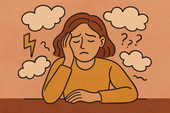
Brain Fog and Fatigue: How to Stop Blaming Yourself
Struggling with brain fog or chronic fatigue? You’re not lazy or failing. Learn how to stop blaming yourself for symptoms caused by MS or chronic illness, and start embracing a more compassionate path to healing and self-understanding.
-

Creating an Emotional Support Team You Actually Trust
Tired of feeling unsupported or misunderstood? Learn how to build an emotional support team you actually trust—with people who see you, hold space for you, and respect your boundaries, especially when living with MS or chronic illness.
-

MS, Vulnerability, and the Fear of Being Seen
Living with MS can make vulnerability feel unsafe. Learn why so many people with MS hide their struggles—and how to gently move toward authenticity, self-acceptance, and deeper connection without shame.
-
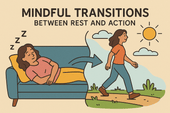
Mindful Transitions Between Rest and Action
Struggling to shift between rest and activity without guilt or overwhelm? This guide offers gentle, mindful strategies to make transitions feel more natural, intentional, and supportive of your nervous system.
-

The Pain of Being Misunderstood—And How to Cope
Feeling the sting of being misunderstood? Learn why it hurts so deeply and discover practical, healing strategies to protect your truth, communicate clearly, and rebuild emotional safety when others just don’t get it.
-

Letting Go of Productivity Guilt When You Need to Rest
Struggling with guilt every time you try to rest? Learn how to release productivity shame, understand why rest matters, and embrace a more compassionate rhythm for healing and recovery—without feeling lazy.
-

Rebuilding Energy Reserves Without Shame
-

What to Do If You Feel Emotionally Invalidated by Doctors
Feeling emotionally invalidated by your doctor can be deeply distressing. Learn how to recognize medical gaslighting, validate your own experience, and advocate for better care when you’re not being heard.
-

How to Rest Without Feeling Lazy
Rest isn’t laziness—it’s a necessary act of self-respect. Learn how to shift your mindset, let go of guilt, and embrace rest as a vital part of mental and physical well-being.
-

Redefining Energy Management as Emotional Self-Care
Energy isn’t just physical—it’s emotional. Learn how redefining energy management as emotional self-care can help you protect your peace, support your nervous system, and live more in tune with your true needs.
-
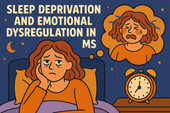
Sleep Deprivation and Emotional Dysregulation in MS
-

How to Cope When Friends Disappear After Diagnosis
Losing friends after a diagnosis can feel like another kind of grief. Discover why some friends disappear—and how to cope with the emotional fallout while building more supportive relationships.
-

How to Talk to Your Kids About MS Without Overwhelming Them
Struggling with how to explain MS to your kids? Learn how to talk to children of all ages about multiple sclerosis with honesty, clarity, and emotional safety—without overwhelming them.
-

MS and the Fear of Emotional Abandonment
The fear of emotional abandonment is common for people with MS. This article explores why it happens, how it impacts your relationships, and how to create emotional safety and healing.
-

Forgiveness, Closure, and Letting Go of the Past with MS
Living with MS often brings emotional wounds from the past. Learn how forgiveness, closure, and letting go can help you heal emotionally—and reclaim peace in the present.
-

Supplements and Habits That Support Sleep and Emotional Balance
Struggling with poor sleep and emotional ups and downs? Discover calming supplements and daily habits that support deep rest and mental well-being—backed by science and easy to implement.
-

When Insomnia Feels Like Your MS Brain Won’t Turn Off
Struggling to sleep with MS? When your brain won’t shut off at night, insomnia feels relentless. Learn what causes it—and discover science-backed strategies to calm your mind and finally rest.
-

The Emotional Toll of Waking Up Tired Every Day: Why It Hurts More Than You Think
Waking up tired every day takes a deep emotional toll—from mood swings to lost motivation and self-doubt. Learn why chronic fatigue hurts more than you think and how to gently reclaim your mornings.
-

Bedtime Anxiety and MS: How to Break the Cycle
Bedtime anxiety is a common struggle for people with MS—and it’s more than just racing thoughts. Learn how MS-related stress, nervous system dysregulation, and fear of symptoms can create a cycle of sleeplessness, and discover practical, calming strategies to finally reclaim restful nights.
-

How Mental Health Affects Sleep Quality in MS: Breaking the Cycle of Fatigue and Emotional Distress
Struggling to sleep when you have MS? Discover how anxiety, depression, and neurological changes impact your rest—and what you can do to reclaim it. From CBT-I and calming supplements to lifestyle tips that support both mental health and sleep, this guide offers practical strategies for better nights.
-

Learning to Love Your Life (Even When It’s Not What You Expected)
Your life may not look how you imagined—but it’s still worth loving. Learn how to find peace, purpose, and joy in the unexpected.
-

Tips for Managing Depressive Thoughts Without Judgment
Learn how to meet depressive thoughts with compassion, not shame. These gentle, research-backed tools help you manage low moods without self-judgment.
-

Rewiring Hope: How to Slowly Come Back to Life
Feeling emotionally numb or disconnected? Learn how to gently rebuild hope, one small sensory step and spark of life at a time.
-

Depression and Suicidality in MS: A Conversation That Needs to Happen
Depression and suicidality in MS are real—and urgent. Learn why we must talk about it, how to spot warning signs, and where to find help and hope.
-

Finding Meaning When Life Feels Empty
Feeling disconnected or numb? Discover gentle ways to find meaning again—even in emptiness—through daily rituals, reflection, and purpose.
-

The Power of Daily Structure in Preventing Mental Health Spirals
Daily structure can prevent mental health spirals by creating safety, routine, and self-trust—especially for those with MS, depression, or anxiety.
-

Healing from Emotional Flatness with Sensory Rituals
Feeling emotionally numb or disconnected? Discover how sensory rituals can gently restore pleasure, presence, and emotional resilience.
-

The Role of Light Therapy for Seasonal Depression and MS
Can light therapy ease seasonal depression in people with MS? Discover the science, benefits, and how to use it safely for better mood and energy.
-

Medication vs Therapy: Treating MS-Related Depression Effectively
Explore whether therapy, medication, or both are best for treating MS-related depression. Understand what works, when—and why combination care is often ideal.
-

How to Support a Partner with MS and Depression
Learn how to support a partner living with MS and depression—practical tips, emotional tools, and ways to protect your own mental health too.
-

The Emotional Cost of Losing Your Old Life
Losing your old life to MS isn’t just about physical symptoms—it’s about grieving the identity, dreams, and freedom you once had. This article explores the emotional toll of invisible grief and how to begin healing without denying the pain.
-
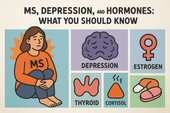
MS, Depression, and Hormones: What You Should Know
MS-related depression isn’t always just emotional—it can be hormonal. Discover how thyroid, sex, and stress hormones influence mood in MS, why women may feel worse during PMS or menopause, and what signs to look for when hormones may be driving emotional instability.
-

MS and Anhedonia: Reclaiming Pleasure One Step at a Time
Anhedonia—feeling emotionally flat or disconnected—is a common but misunderstood symptom of MS depression. This article explores how neuroinflammation, dopamine disruption, and fatigue can dull your sense of joy—and how small, gentle steps can help you begin to feel again.
-
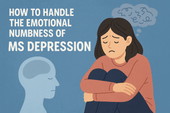
How to Handle the Emotional Numbness of MS Depression
Emotional numbness in MS depression doesn’t always look like sadness—it can feel like nothing at all. Learn why this disconnection happens, how it's tied to neuroinflammation and nervous system overload, and discover science-backed strategies to gently reconnect with your emotions.
-
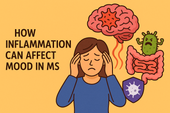
How Inflammation Can Affect Mood in MS
Mood swings and emotional numbness in MS aren’t just psychological—they can be driven by immune system inflammation. This article explores how inflammatory cytokines affect the brain, why mood changes are often biological, and what you can do to calm your nervous system from the inside out.
-
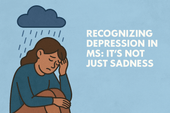
Recognizing Depression in MS: It's Not Just Sadness
Depression in multiple sclerosis (MS) is more than just sadness—it can be a neurological symptom, a side effect of inflammation, or a silent weight that masks itself as fatigue or emotional numbness. This article helps you recognize the hidden signs of MS-related depression, understand the science behind it, and explore real treatment options that support both mental and physical health.
-

Is Cryotherapy Safe for MS? Pros, Cons, and How It Compares to Cold Plunges
Cryotherapy promises quick recovery, inflammation reduction, and mood support—but is it safe for people with MS? This article breaks down the science, risks, and real-life benefits of cryotherapy for multiple sclerosis. You’ll also learn how it compares to cold plunges and which option may be better for calming flares and regulating your nervous system.
-

Can Cold Plunges Help Reduce Inflammatory Flares in MS?
Flares in multiple sclerosis (MS) are often driven by inflammation—but what if cold water could help turn down the heat? This in-depth article explores how cold plunges may help reduce flare frequency and intensity in MS by calming the immune system, lowering pro-inflammatory cytokines, and regulating the nervous system. Learn how to safely use cold exposure as part of your MS recovery routine.
-
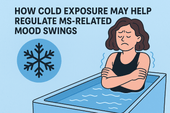
How Cold Exposure May Help Regulate MS-Related Mood Swings
Mood swings are a common but overlooked challenge in multiple sclerosis (MS). This article explores how cold exposure—like cold plunges and showers—may help regulate emotional ups and downs by calming the nervous system, reducing inflammation, and boosting mood-enhancing chemicals. Learn how to use this natural tool safely to support your mental and emotional resilience with MS.
-
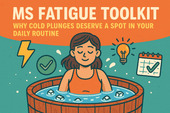
MS Fatigue Toolkit: Why Cold Plunges Deserve a Spot in Your Daily Routine
Fatigue is one of the most debilitating symptoms of multiple sclerosis (MS)—often invisible, misunderstood, and overwhelming. While no single tool can eliminate it, building a personalized fatigue management toolkit can make life more manageable. One surprising contender? Cold plunges. In this article, we explore why cold water immersion might be the refresh button your nervous system needs—and how to safely make it part of your MS fatigue routine.
-
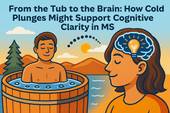
From the Tub to the Brain: How Cold Plunges Might Support Cognitive Clarity in MS
Cognitive fog is one of the most frustrating symptoms of multiple sclerosis (MS). But could cold plunges—those bracing dips into icy water—offer a surprising path to mental clarity? This article explores the emerging science behind cold exposure, brain function, and how a cold tub might help people with MS sharpen focus, lift brain fog, and reset their nervous system.
-
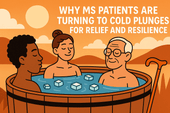
Why MS Patients Are Turning to Cold Plunges for Relief and Resilience
Cold plunges are no longer just for elite athletes and wellness influencers. A growing number of people with multiple sclerosis (MS) are turning to cold water immersion to ease symptoms, build nervous system resilience, and find calm in the chaos of chronic illness. This article explores why—and how—you might want to give it a try.
-
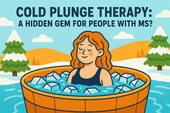
Cold Plunge Therapy: A Hidden Gem for People with MS?
Cold plunge therapy—once the domain of elite athletes and biohackers—is gaining attention among people with multiple sclerosis (MS). Could it help reduce inflammation, calm the nervous system, and ease MS symptoms like fatigue and spasticity? In this article, we dive deep into the science, benefits, safety, and practical application of cold plunges for MS recovery and symptom relief.
-
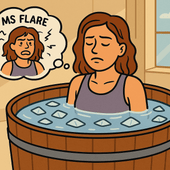
Finding Relief in the Midst of a Flare
MS flares can leave you feeling overwhelmed, exhausted, and mentally foggy. Cold water therapy is emerging as a promising tool to help reset the body and mind after a flare. This article explores how cold exposure supports recovery, calms the nervous system, and can be safely added to your daily routine.
-
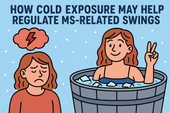
How Cold Exposure May Help Regulate MS-Related Mood Swings
Mood swings in multiple sclerosis (MS) can feel like emotional whiplash—one moment calm, the next overwhelmed, angry, or hopeless. While medications and therapy help, many people with MS are exploring natural strategies to support emotional balance. One surprising tool gaining attention? Cold exposure. In this article, we explore how cold plunges and other forms of cold therapy may regulate the nervous system, stabilize mood, and offer emotional relief for people with MS.
-
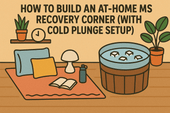
How to Build an At-Home MS Recovery Corner (with Cold Plunge Setup)
Create your personal MS recovery oasis at home—complete with a cold plunge setup. Learn how to design a space that supports healing, reduces inflammation, and helps you manage symptoms naturally.
-
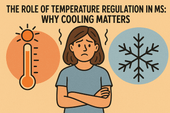
The Role of Temperature Regulation in MS: Why Cooling Matters

















































